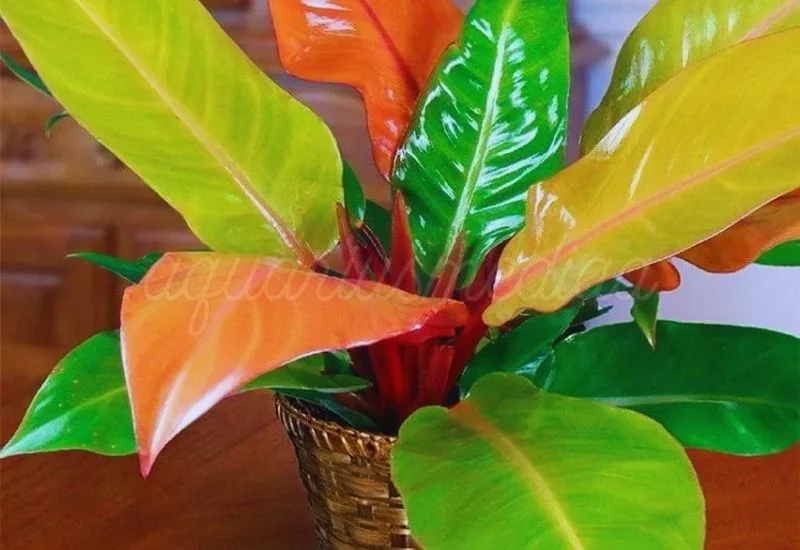In this blog post, you’re going to learn how to easily propagate and care for Philodendron Prince of Orange.
This is a comprehensive guide covering reliable information about different aspects of this cultivated variety.
In this post, I’ll cover:
Interesting Facts
Propagation
Repotting
Care
And
Solutions to Common Problems
So, if you are looking to propagate and care for Philodendron Prince of Orange, this guide is for you.
Fun Facts
| Common Name | Prince of orange |
| Botanical Name | Philodedron “prince of orange” |
| Family | Araceae |
| Plant Type | Perennial |
| Fruit | Usually fon’t produce fruit |
| Mature Size | 24 to 35 inches tall |
| Sun Exposure | Shade (partial) |
| Soil Type | Well draining |
| Soil pH | Acidic |
| Native Area | Central and South America |
| Toxic | Toxic to humans and pets both |
| Growth | Fast growing |
This species of philodendron is known for its orange-colored bi-lobed leaves. It has long, bigger, and marginated leaves. This characteristic of the Prince of Orange makes it the best choice for indoor designs.
P. prince of orange is a fast-growing species. It gets it leaves very fast when there are favorable conditions. This species reaches its maximum size of 2-3 feet in up to two years.
Flower and Fruiting Structure
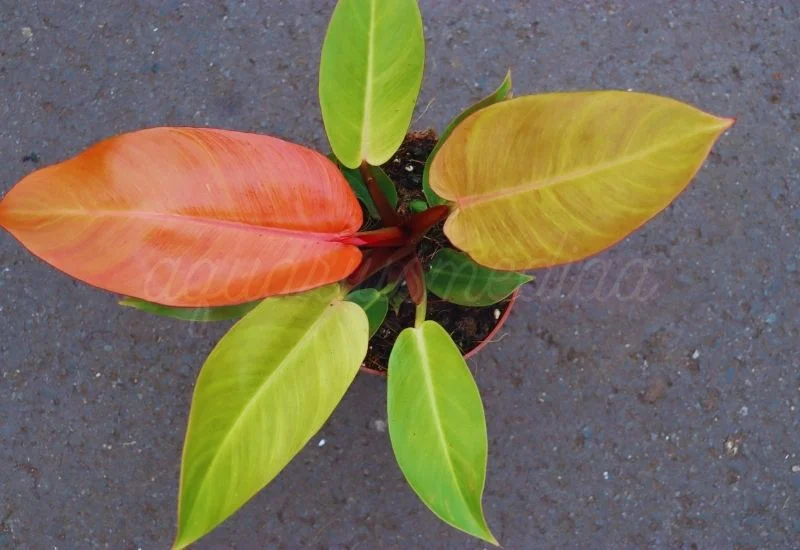
Flowering and fruiting are not significant characteristics. It is only known for its aesthetic foliage look. The flowers of the plant are not too apparent. It has a small spathe covered by a white spadix. This species of philodendron usually doesn’t produce fruits.
However, small fruits are rarely seen in the natural environment that are used to disperse the seeds.
Benefits
Let’s explore the some potential benefits of this philodendron’s species;
Vibrant Foliage
Its leaf structure and color are extraordinary, vibrant, and splashy. In addition to the structure, its unique color makes it more catchy. Ultimately, this combination results in its prominent space in home decor and design.
Compact Size
This plant is not as large and vining as other philodendrons, so it is more appropriate for confined spaces. It is relatively compact and can thus be located on desks, shelves, and even windowsills, which may give it significant prominence.
Low Maintenance
Over time, this plant has become accepted as low-maintenance and needs less attention than most indoor plants. It prefers bright light but can be adjusted anywhere, even if the light is relatively low.
Pets Resistant
Prince of orange is not easily infested with the primary pests of house plants, such as spider mites and aphids, etc.
As with most philodendron species, the Prince of Orange is perfectly capable of purifying the air. It assists in purging indoor air pollutants such as formaldehyde, benzene, lead, and carbon monoxide, making the indoor air fresher.
Increase Humidity
The plant also gives off moisture into the air through transpiration. This rise in humidification can be advantageous, especially in climate-controlled environments.
Versatility
Due to its deep red/orange color, the Philodendron Prince of Orange is helpful in interior design. It also goes well with almost any theme, from modern and sleek to boho-chic and shabby chic.
Uses
This Philodendron species comes with several uses and benefits, such as the following:
- The very first use of Prince of Orange is its aesthetic appeal. It has a very beautiful and attractive color pattern. People keep it in the interior and exterior of the home as a decorative piece.
- The benefit of this species is that they are very easy to propagate. You don’t have to worry about caring for this philodendron. You can keep them in normal household conditions.
- Another important use of this plant is its air purification capability. It cleans the air by taking carbon dioxide and other chemicals from the air. Moreover, their large porous leaves filter the air in the room. Their shiny surface reflects the sunlight and makes the room full of light.
Propagation
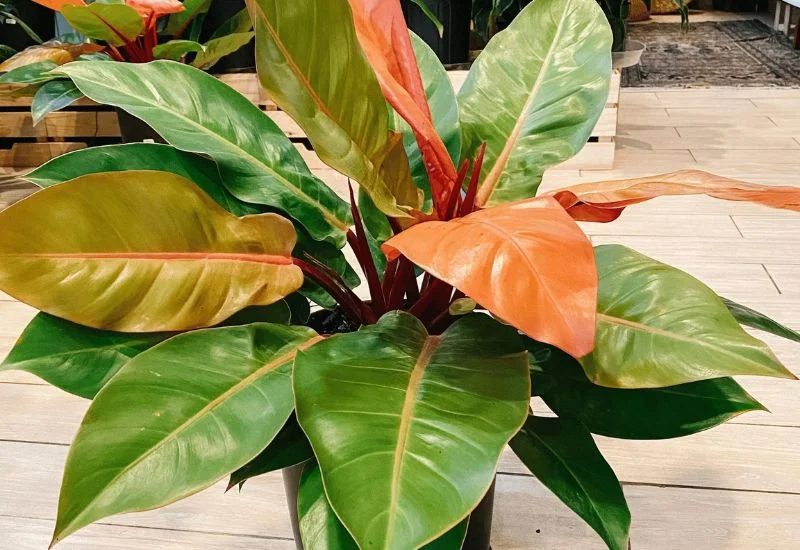
Most people propagate Prince of Orange through cuttings. Firstly, they choose a stem that has leaves and nodes on it. They cut it into a size of about 16 inches. Then, the cutting is placed in the growing medium. Most people use seedling compost. Now, a temperature of 20 to 25 °C is maintained around this cutting.
As this plant is tropical, it will require a high humidity level. You can keep it in the washroom or kitchen. Another way to increase humidity is to install a small humidifier for optimum growth.
Experts recommend propagating this plant in the spring season. Moreover, they suggest using a sterile knife or pair of scissors for cutting purposes.
Repotting
Repotting is very common for a lover of Philodendrons. Usually, this process is carried out once a year. However, if your Philodendron species is slow-growing, you can do it once in two years. The most commonly observed signs for repotting are the following:
- The roots start sprouting from the drainage holes of the pot.
- The roots accumulate in the pot. Their size increases than the quantity of the soil in the pot.
- The leaves start wilting and slow down their overall growth.
When you observe these signs, you should buy a pot two to three inches larger than the previous one. Then you have to water your Philodendron to wet its soil. So that you can easily remove the soil by squeezing and then removing the plant. You have to trim the damaged, diseased, and dead roots from the plant.
Now, you should prepare the soil mixture and fill the bottom layer of the new pot. Then, hold your Philodendron in the center of the pot and fill the soil slowly around the plant. You have to keep the soil porous. Now, water it in a small quantity.
The first week is very crucial for the plant. You have to provide ideal conditions. After this, you can keep it in normal condition. It is recommended that repotting should be done during the growing season, spring.
Care
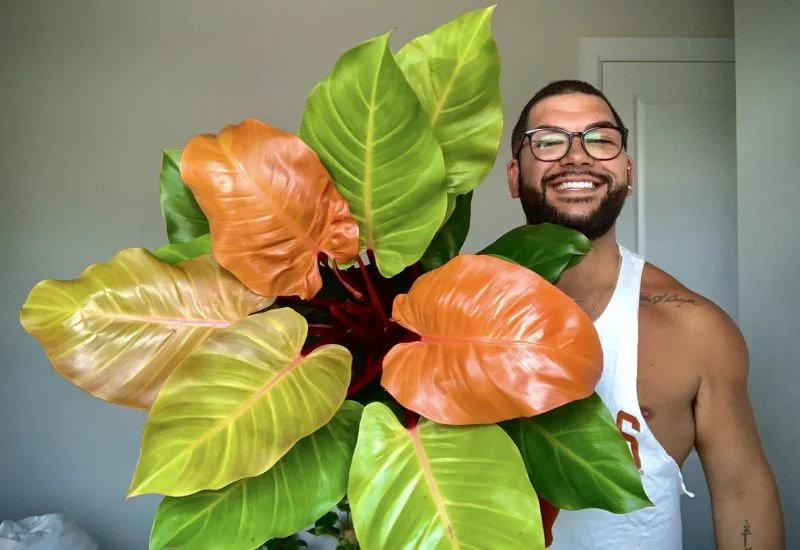
If you are fond of Prince of Orange, you don’t have to worry about the care of this Philodendron. You just have to provide indirect sunlight, proper water, high temperature, and high humidity.
Let’s discuss the ideal conditions for this plant:
Soil
The ideal soil for your philodendron will be fertile, porous, light, can hold water, and loose. You can easily prepare this soil at home, or you can buy it. If you want to prepare it at home, you have to mix the following items:
- Potting soil
- Peat
- Perlite
- Orchid or coconut coir
Pot
Different materials are used to make pots, such as plastic, wood, metal, and terracotta. However, terracotta material is considered best for Prince of Orange. You can determine its size by comparing the root ball with the diameter of the pot.
The diameter of the pot must be two to three inches larger than the root ball. Moreover, you have to ensure that the walls of the pot are small holes to drain the extra water.
Water
These plants are very sensitive to the quantity of water. You have to water enough to soak the roots and soil, but it doesn’t accumulate in the pot. That’s why porous pots are preferred.
You should water them once a week in the summer season and once in two weeks in the winter season. You can verify that the above layer of the soil is fully dry before watering it.
Light
These Philodendron species are also known as shady plants. They need only indirect sunlight. You can keep it in front of windows on the lawn and in the kitchens. It needs a minimum of eight hours of indirect sunlight.
Direct sunlight can cause the leaves to burn or wilting. Moreover, this can result in the death of the plant.
Fertilizer
Fertilizers are required to fulfill the nutrient requirement during growth. You can make the best use of fertilizer by the following tips:
- You should use slow-dissolving fertilizer. So that it can provide nutrients for a longer period of time and they don’t drain in the water.
- Spring is the best time to fertilize your Philodendron. Philodendron has the maximum growth rate in this season.
- You have to research the nitrogen-rich fertilizers. The perfect ratio for nutrients in the fertilizer is 10: 10: 10 of NPK.
Placement
You have to choose a place where only indirect sunlight falls but for a longer period of time. Moreover, you have to consider the aesthetics of your home. So, the best places are the front windows that face the sun from the north.
You can choose the windows of your lawn, kitchen, and washroom.
Pruning
The main purpose of pruning is to make it more attractive and enhance its growth rate. By the way, it doesn’t really need pruning again and again. You just have to remove the dead or damaged leaves and branches with a sharp and sterilized knife.
Common Problems
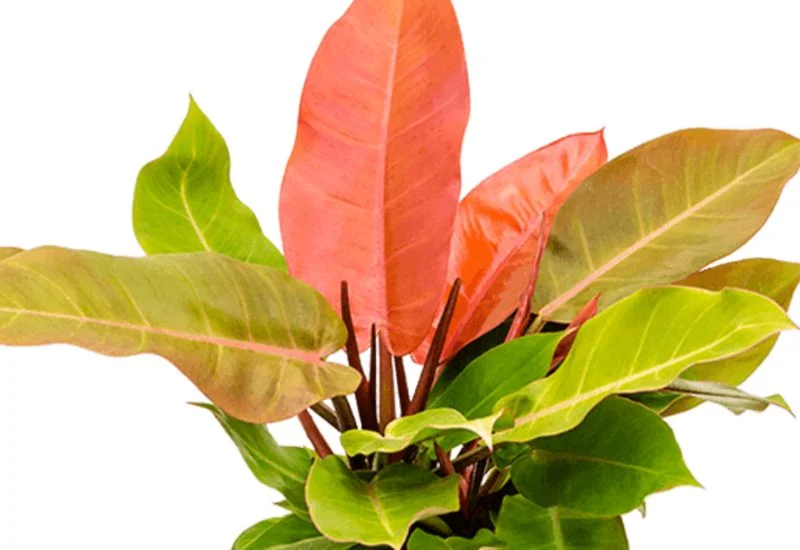
Unlike other Philodendron species, Prince of Orange is not as much exposed to diseases and other growth problems. However, you should keep an eye on it for any type of issues discussed below:
Pests
The pests that can attack Prince of Orange are aphids, spider mites, scale, mealy bugs, thrips, etc. You can easily check the symptoms of these pests. They form webs on the leaves, which causes the yellowing and wilting of the leaves to occur.
You can treat them through the spray of pesticides, alcohol, or neem oil.
Fungal Diseases
Fungi cause spots on the leaves of Philodendron. You can observe the brown, black, and yellow spots on the leaves. The fungus attacks these leaves in damp and shady conditions. As a result of such attacks, the leaves can wilt, curl, or die.
When you see any of the spots on the leaves, you have to remove them immediately. Then, you can spray any fungicide on the left. However, you can protect your Philodendron from fungal attacks by maintaining healthy conditions.
You have to provide it with a suitable amount of water and keep it in the indirect sunlight for eight hours a day. Moreover, don’t keep any infected plants, and never use unsterilized tools.
Brown Tips
Brown tips appear as a symptom of direct sunlight, over-watering, and under-watering. These are not a big issue until all the leaves appear brown. The ultimate result is the death of the leave.
Curling Leaves
The curling of leaves mainly occurs due to watering problems. If the quantity of the water exceeds, the leaves curl in a downward direction. However, if the plant doesn’t get the desired amount of water, its leaves curl in direction.
Moreover, the amount of sunlight and humidity levels also affect the leaf’s shape.
Yellow leaves
The young leaves of this Philodendron are generally yellow. However, if you observe yellowing in the mature green and orange leaves, it can be a sign of low temperature, low humidity, and wrong positions for sunlight.
So, you have to immediately change the position of Prince of Orange when you observe yellowing in its leaves.
